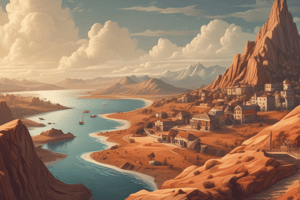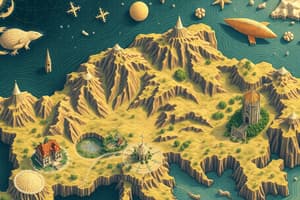Podcast
Questions and Answers
Which of the following best describes the focus of geography as a field of study?
Which of the following best describes the focus of geography as a field of study?
- The interaction between the physical environment and human populations. (correct)
- The exploration of outer space and celestial bodies.
- The analysis of economic systems and financial markets.
- The study of historical events and their impact on societies.
Human geography primarily focuses on studying landforms, climate zones, and natural resources.
Human geography primarily focuses on studying landforms, climate zones, and natural resources.
False (B)
What is the main process that forms a delta?
What is the main process that forms a delta?
deposition
A large hill with steep sides is typically referred to as a ______.
A large hill with steep sides is typically referred to as a ______.
Match the following landforms with their descriptions:
Match the following landforms with their descriptions:
Which of the following pieces of evidence supports the theory of continental drift?
Which of the following pieces of evidence supports the theory of continental drift?
According to the theory of continental drift, the continents have always been in their current positions.
According to the theory of continental drift, the continents have always been in their current positions.
What is the name of the supercontinent that existed millions of years ago?
What is the name of the supercontinent that existed millions of years ago?
The process by which rocks, soil, and minerals are broken down into smaller pieces is known as ______.
The process by which rocks, soil, and minerals are broken down into smaller pieces is known as ______.
Which natural factor is responsible for transporting weathered materials to new locations?
Which natural factor is responsible for transporting weathered materials to new locations?
Deposition is the process of breaking down rocks into smaller pieces.
Deposition is the process of breaking down rocks into smaller pieces.
What type of natural force within the Earth causes the movement of tectonic plates?
What type of natural force within the Earth causes the movement of tectonic plates?
The process by which landforms become covered in glaciers or ice sheets, leading to changes in the landscape, is called ______.
The process by which landforms become covered in glaciers or ice sheets, leading to changes in the landscape, is called ______.
Match the following natural factors with their effects on landforms:
Match the following natural factors with their effects on landforms:
Which of the following human activities involves creating new land in bodies of water?
Which of the following human activities involves creating new land in bodies of water?
Mining always involves digging underground tunnels to extract resources.
Mining always involves digging underground tunnels to extract resources.
What materials are typically used to fill water bodies during land reclamation projects?
What materials are typically used to fill water bodies during land reclamation projects?
The process of extracting resources from the earth, which can involve both underground and open-pit methods, is known as ______.
The process of extracting resources from the earth, which can involve both underground and open-pit methods, is known as ______.
Which of the following is a direct consequence of tectonic forces?
Which of the following is a direct consequence of tectonic forces?
Volcanoes are formed when magma swells under the surface of the earth pushing the land up into a tall landform with a mostly flat top.
Volcanoes are formed when magma swells under the surface of the earth pushing the land up into a tall landform with a mostly flat top.
Flashcards
What is Geography?
What is Geography?
The study of the physical features and human populations on Earth, examining their interactions and impacts.
Mountain
Mountain
Large hill with steep sides, formed when pieces of the Earth collide and are forced upwards.
Valley
Valley
Low spaces between hills or mountains, often created by vegetation.
Plateau
Plateau
Signup and view all the flashcards
Volcano
Volcano
Signup and view all the flashcards
Desert
Desert
Signup and view all the flashcards
Delta
Delta
Signup and view all the flashcards
Island
Island
Signup and view all the flashcards
Continental Drift
Continental Drift
Signup and view all the flashcards
Tectonic Forces
Tectonic Forces
Signup and view all the flashcards
Weathering
Weathering
Signup and view all the flashcards
Erosion
Erosion
Signup and view all the flashcards
Deposition
Deposition
Signup and view all the flashcards
Glaciation
Glaciation
Signup and view all the flashcards
Land Reclamation
Land Reclamation
Signup and view all the flashcards
Study Notes
- Geography is the study of Earth's physical features and human populations.
- Geographers study the interactions between the physical environment and human populations.
Physical Geography
- Physical geography studies landforms, rocks, and minerals.
- The study of different plants, animals, physical features, and natural resources are components of physical geography.
- Understanding climate zones is also part of physical geography
Human Geography
- Human geography explores different economic systems.
- It studies human interaction with the Earth and their impact.
- Understanding different cultures is a key aspect.
- Examining human migration patterns is important in human geography.
- Studying population characteristics falls under human geography.
Landforms
- Mountains are large hills with steep sides formed when Earth's plates collide and force land upwards.
- Valleys are low areas between hills or mountains, often created by vegetation.
- Plateaus are large, elevated areas with mostly flat tops, formed by erosion or magma swells.
- Volcanoes are mountains that erupt, allowing molten lava to flow out.
- Deserts are areas where evaporation exceeds precipitation.
- Deltas are triangular landforms at river mouths, created by sediment deposits.
- Islands are landmasses surrounded by water, formed by cooled lava, sediment buildup, or separation from larger landmasses.
Continental Drift
- Alfred Wegener proposed the theory of continental drift.
- Millions of years ago, all continents were one giant landmass called Pangea.
- Pangea slowly broke apart into the continents we know today.
- The coastlines of South America and Africa appear to fit together.
- Plant fossils and natural resources found in unexpected locations support the theory.
- Geological evidence in Antarctica is similar to that in North America, suggesting a past connection.
Natural Factors Changing Landforms
- Landforms change over time due to natural and human factors.
- Tectonic forces, weathering, erosion, deposition, and glaciation are natural factors in this change.
Tectonic Forces
- The Earth's crust consists of major and minor plates that are constantly moving due to forces within the lithosphere.
Weathering
- Weathering is the natural process of breaking down rocks, soil, and minerals into smaller pieces.
Erosion
- Erosion moves weathered materials to new locations via ice, wind, water, and living organisms.
Deposition
- Deposition is the process where eroded soil and rock are transported and deposited in new locations, creating new landforms.
Glaciation
- Glaciation is the process of landforms being covered by glaciers or ice sheets, which alters them.
Human Factors Changing Landforms
- Mining involves digging underground or extracting resources from open pits.
- Land reclamation creates new land in bodies of water by filling areas with rock or cement, then adding clay or dirt.
Studying That Suits You
Use AI to generate personalized quizzes and flashcards to suit your learning preferences.




